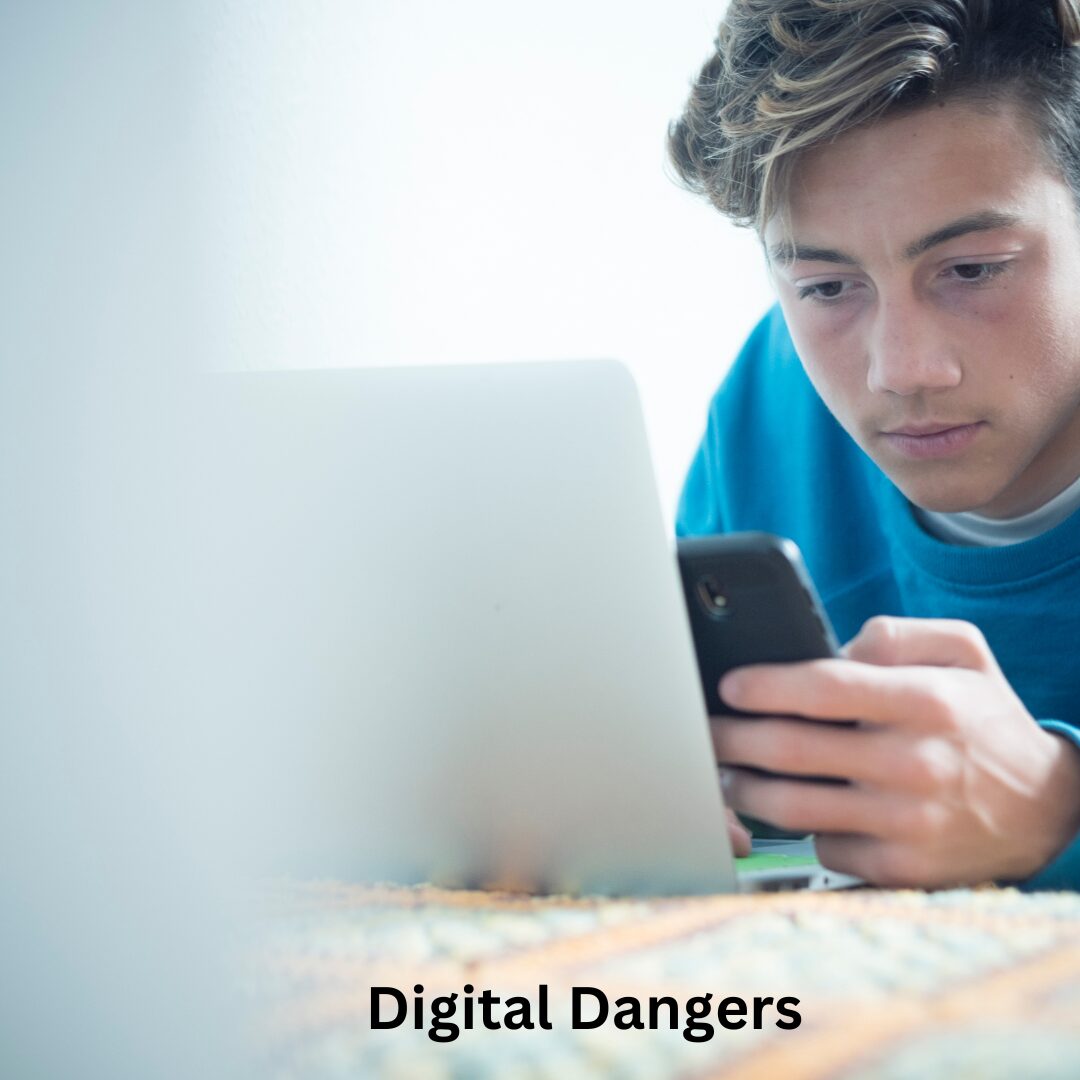Digital Dangers: Helping your child steer clear of the risks
By: Brandi Timmons, MEd, BCBA, LBA & Brodie Simmons, LPC, LCDC
Children with autism may often encounter significant challenges in discerning the boundaries between friends, acquaintances, and strangers, which can make them particularly vulnerable to exploitation or harm. Difficulty interpreting social cues and understanding the nuances of interpersonal relationships may lead to a certain level of naivety, where they may not recognize potentially dangerous situations or individuals. A study published in 2022 found that as many as 44% of autistic individuals have been victimized in some way.1 Without the ability to differentiate between genuine friendships and deceptive intentions, children with autism may inadvertently trust individuals who seek to take advantage of them.
Additionally, their inherent trust and desire for acceptance may further increase their vulnerability, as they may not question the motives of others or recognize warning signs of potential harm. As a result, autistic individuals are encountering the criminal justice system as victims, offenders, and witnesses at high rates.2
For many children with autism, online platforms serve as vital avenues for social interaction and connection. In a world where face-to-face communication can be daunting, the digital realm offers a safe and comfortable space for them to engage with others. Online interactions often mitigate the challenges associated with reading social cues and navigating non-verbal communication, allowing these individuals to express themselves more freely. Consequently, they may find solace and companionship in virtual communities, fostering relationships through shared interests, gaming, or other online activities. Spending considerable time gaming online is common for autistic individuals, as it provides structured environments and transparent rules, offering a sense of predictability and control that may be lacking in offline interactions.
Compound the naivety that can make them more susceptible to manipulation or exploitation with the already inherent dangers of the online world, and autistic individuals become even more vulnerable. Because of this, they may unintentionally become victims of online predators, fall prey to financial scams, or even commit online offenses.
How do we alleviate the danger? Caregivers and educators must provide comprehensive education and support to this population to help them navigate social interactions safely and develop the skills necessary to recognize and respond to potentially dangerous situations. Crime Stoppers of Houston, a non-profit dedicated to public safety in Houston, Texas, USA, has recently launched the N.E.E.D.S. (Neurodiversity, Educate, Empower, Deliver, Safety) program (https://crime-stoppers.org/safe-school-institute/needs-special-needs-education) to provide critical preventative education for this population. The N.E.E.D.S. team will provide training and tools to individuals, schools, caregivers, and law enforcement regarding risk management, crime prevention, and guidance on contacting authorities or appropriate intervention in case of criminal involvement. More initiatives like this are needed to ensure individuals with autism have the most significant opportunity for safety.
You may feel like keeping your child, teen, or young adult safe while they are online is impossible, but there are some key areas that you can address to increase the likelihood of their safety:
- COMMUNICATION
Communication may seem the most obvious, but it may also be the most effective strategy. Parents/caregivers need to proactively discuss online safety with their children to equip them with the necessary skills and strategies to navigate the digital landscape responsibly. Even brief conversations while doing something together – cooking, driving home from school, watching a TV show, etc. – can be helpful. Many of our children learn well through direct instruction – a teaching method where you clearly explain information step-by-step. Learning online safety will not happen overnight. One discussion will not be enough. You may need to have frequent conversations, even repeating the same discussions repeatedly, until the concept is understood and your child can apply the knowledge.
Parents can play a pivotal role in promoting a safe and positive online experience for their children by fostering open communication, teaching critical thinking skills, and establishing clear rules and boundaries.
- Establish Open Communication: Parents should cultivate an environment where their children feel comfortable discussing their online experiences without fear of judgment or punishment. Encourage open dialogue by actively listening to their concerns, questions, and experiences. Fostering trust and understanding can help parents create a safe space for their children to seek guidance and share any online safety concerns.
- Teach Critical Thinking and Decision-Making Skills: Empower children with the tools to critically evaluate online content and make informed decisions about their digital interactions. For instance, show them specific examples of details that may be a sign of a phishing scam (i.e. the email says your account is on hold because of a billing issue3). Discuss the importance of verifying information, recognizing potential risks, and setting boundaries for online communication. Encourage them to question the credibility of websites, scrutinize messages from unfamiliar individuals, and assess the possible consequences of sharing personal information online. Parents can help their children navigate the online world more safely and responsibly by instilling these critical thinking skills.
- Set Clear Rules and Boundaries: Establishing clear rules and boundaries regarding online behavior is essential for promoting responsible digital citizenship and ensuring online safety. Many individuals with autism like having rules and boundaries. Work with your child to develop age-appropriate guidelines for internet use, such as setting time limits, identifying appropriate websites and apps, and establishing privacy settings on social media platforms. Reinforce the importance of adhering to these rules and regularly revisit them to address emerging concerns or changes in online activities. By setting clear expectations and boundaries, parents can help their children develop healthy online habits and minimize the risks associated with internet use.
- ACCOUNTABILITY
Accountability is crucial in enhancing online safety, particularly for young people. When individuals are aware that their online activities can be monitored by their parents or guardians, it instills a sense of responsibility. It encourages them to make more cautious decisions on the internet. This awareness can be a preventive measure against engaging in risky behaviors or accessing harmful content. Fostering an environment where actions are reviewed and discussed helps promote safer online practices and provides guidance and education on responsibly navigating the digital world.
- Implement Parental Controls and Monitoring Software: Parents can utilize parental control tools and monitoring software to oversee their children’s online activities and ensure their safety. These tools allow parents to restrict website access, block inappropriate content, and monitor their child’s browsing history and online interactions. By configuring parental controls on devices and internet browsers, parents can establish age-appropriate boundaries and protect their children from encountering harmful content or interacting with potentially dangerous individuals online. Below are several tools available:
Monitoring tools:
https://us.norton.com/products/norton-family
List of kid-safe browsers: https://www.commonsensemedia.org/lists/kid-safe-browsers-and-search-sites
Google SafeSearch: https://support.google.com/websearch/answer/510?co=GENIE.Platform%3DAndroid&hl=en
- Consider the location of devices: Placing a computer in a communal area, such as a hallway or the back of the family room, encourages openness and supervision, rather than allowing children to have their own computer in their bedrooms where activities can be hidden from parents. It’s also important to acknowledge that your kids might try to hide their mobile devices from you. Establishing a rule where parents know the password and conduct random spot checks can foster a culture of accountability and transparency. Communicating the possibility of these checks to children and following through with them helps maintain a balance between respecting their privacy and ensuring their safety online.
- Set Time Limits and Establish Tech-Free Zones: Establishing clear guidelines for screen time and creating tech-free zones within the home can help parents regulate their children’s online habits and promote healthy digital behaviors. Parents can set specific time limits for internet use and encourage alternative activities such as outdoor play, reading, or spending time with family and friends. Additionally, designating certain home areas, such as bedrooms or dining areas, as tech-free zones can encourage offline interactions and reduce reliance on digital devices. Parents can help their children develop healthy habits and maintain a positive relationship with the internet by establishing boundaries around screen time and promoting a balanced approach to technology use.
- MODEL HEALTHY DIGITAL BEHAVIORS
Children often mimic their parents’ behaviors, so parents need to demonstrate responsible internet use and set a positive example. This includes practicing moderation with screen time, maintaining a balance between online and offline activities, and prioritizing real-life interactions over excessive digital consumption. By demonstrating behaviors such as engaging in device-free activities, respecting designated tech-free times and zones, and prioritizing face-to-face communication, parents can instill healthy habits in their children and create a supportive environment for responsible internet use.
- Spend quality time: By spending quality time together without digital devices, parents can emphasize the value of personal interaction and teach children the importance of privacy and discretion in both the physical and digital worlds. Activities such as playing board games, reading books together, or engaging in outdoor activities not only strengthen familial bonds but also provide opportunities for parents to discuss and demonstrate the principles of respect, empathy, and caution crucial for navigating online environments safely. Even mundane tasks like running errands or bringing kids to events (work or play) are good opportunities to model “lessons” about meeting new people, making friends, and the differences between friends and acquaintances. Through these shared experiences, children can learn to appreciate the benefits of digital tools while understanding the importance of maintaining healthy boundaries and safe practices online, mirroring the positive behaviors modeled by their parents offline.
- Respect tech-free times and zones: Strictly respecting designated tech-free times and zones within the household teaches the importance of balance between digital and real-world activities, fostering an environment where technology is used responsibly. Your respect for tech-free moments encourages face-to-face interaction and ensures that family members are present and engaged with each other rather than being absorbed in their devices. Tech-free zones help instill a sense of privacy and tranquility, reducing the risks of digital distractions and promoting better sleep for everyone. These practices mitigate the risks associated with excessive screen time, such as cyberbullying and exposure to inappropriate content, and teach children to value personal interaction and downtime, laying the foundation for a balanced and healthy digital lifestyle.
- Prioritize face-to-face communication: Face-to-face communication can significantly enhance online safety. These experiences teach children practical communication skills, such as reading non-verbal cues, understanding tone, and practicing empathy—skills that are crucial for navigating online interactions safely and respectfully. When children observe their parents and participate in ‘getting to know you’ conversations, they learn to ask appropriate questions, share information safely, and discern personal privacy boundaries. Such real-world experiences also provide a practical context for discussing the differences between online and offline interactions, highlighting the importance of being cautious about the information they share and whom they trust online. By modeling how to meet new people and engage in conversations safely and respectfully, parents can guide their children in applying these principles to their online behavior.
Navigating the waters of online safety for kids, teens, and even young adults can be challenging. Adding the autism component may compound the challenges. You can expect pushback on limitations regarding time spent online and resistance to parental controls on their digital activities. You may even receive arguments favoring online relationships they perceive as genuine friendships. However, as parents, it’s crucial to stand firm in your decisions and not fall into complacency. Embracing your role means actively learning about the technology your children use and leveraging resources offered by schools or law enforcement to stay informed about the latest online threats. By doing so, you demonstrate a commitment to not just understanding their digital world but also protecting them within it.
Digital dangers are real. But the internet and all it offers – good and bad – is here to stay. As a parent/caregiver, the quest to keep your child with autism safe can feel daunting. You, however, have access to tools and resources to teach the skills your child needs to become more aware, wiser, and less vulnerable. Take the first step and start a conversation today.
- Trundle, G., Jones, K. A., Ropar, D., & Egan, V. (2023). Prevalence of Victimisation in Autistic Individuals: A Systematic Review and Meta-Analysis. Trauma, Violence, & Abuse, 24(4), 2282-2296. https://doi.org/10.1177/15248380221093689
- Shea LL, Cooper D, Wilson AB. Preventing and improving interactions between autistic individuals and the criminal justice system: A roadmap for research. Autism Res. 2021 Oct;14(10):2053-2060. doi: 10.1002/aur.2594. Epub 2021 Aug 17. PMID: 34402601.
- https://www.allconnect.com/blog/autism-online-safety
Brandi Timmons, MEd, BCBA, LBA has over two decades of experience as a special educator, championing the potential in autistic children and adults by fostering environments that spotlight their strengths. Brandi’s contributions extend beyond classrooms. She’s a writer and researcher, state and national speaker, curriculum designer, and program creator. Most recently she has co-founded Spectrum Linx, a pivotal resource for families of autistic members that provides support, guidance, and knowledge at every stage of the autism journey.
https://www.facebook.com/spectrumlinx
https://www.instagram.com/spectrumlinx
Brodie Simmons has dedicated his 15-year career to supporting individuals and families grappling with pervasive mental illnesses or addiction. He specializes in individual therapy, parent coaching, and intensive psychotherapy as a Licensed Professional Counselor Supervisor and Licensed Chemical Dependency Counselor. He is the Clinical Director of Advance Houston, a program tailored for neurodiverse young adults striving for increased independence. His commitment to fostering community well-being extends beyond his therapeutic practices through his podcast, Life Together with Brodie, where he guides conversations with guests who share their mental health journey and offers practical advice for listeners. He also serves on the advisory board for NEEDS, a program by Crime Stoppers of Houston, delivering a specially crafted curriculum for special needs students in public schools. Brodie is a proud father of four wonderful children and loves spending time with his family and friends doing as much of life together as he can!
www.lifetogetherwithbrodie.com
www.brodiesimmonscounseling.com
https://www.instagram.com/lifetogetherwithbrodie
https://www.facebook.com/profile.php?id=61557236274093
As originally seen in Autism Parenting Magazine





